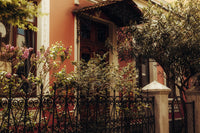Decorative iron fences are a type of fence you’ll often see around homes, gardens, and even commercial properties. They are made from strong iron but with a ornamental or decorative details.
What makes them so popular? For one, they’re incredibly durable. They also offer a level of security that other materials like wood or vinyl can’t match. On top of that, they come in a wide range of designs: simple, classic and custom-made, making it easy to find or create a style that suits your property.
Advantages of Installing Decorative Wrought Iron Fence
- Durability: Decorative wrought iron fence is built to last. It can withstand harsh weather, resist damage, and won't warp or crack like wood. These fences can last for decades with the right care, resisting wear and tear from weather and time.
- Security Enhancements: This type of fencing adds a solid layer of security to your property. The strong iron bars make it difficult to breach, helping keep your home or business safe from intruders.
- Aesthetic Versatility: One of the biggest perks of ornamental iron fencing is how versatile it is. You can choose from different designs, whether you want something simple and modern or intricate and traditional, to match your space.
- Low Maintenance: Compared to other materials, wrought iron fencing doesn’t require a lot of upkeep. As long as you clean it occasionally and check for rust, it stays in good shape without much effort.
- Longevity and Strength: Iron fencing offers a level of strength you just don’t get with other materials. It holds up well over time and doesn’t need frequent replacement, making it a cost-effective long-term option.
Potential Downsides of Decorative Iron Fencing
- Higher Upfront Costs: Decorative iron fencing can be more expensive to install compared to other materials like wood or vinyl. The cost reflects its durability and style, but it might not fit everyone's budget.
- Installation Challenges: Installing wrought iron fencing isn’t a simple DIY project. It often requires professional expertise and specialized tools, which can add to the overall cost and time.
- Potential for Rus: Even though wrought iron is strong, it’s prone to rust if not properly maintained. Over time, exposure to moisture can cause rust spots, so regular maintenance is important to keep the fence looking good.
- Privacy Considerations: Wrought iron fences are typically designed with open spaces between the bars, which means they don’t offer much privacy. If privacy is a priority, you might need to combine them with other elements like shrubs or panels.
Common Applications of Ornamental Wrought Iron Fences
Residential
Decorative wrought iron is commonly used in residential settings for more than just fencing. One popular application is handrails, whether for front steps, balconies, or staircases inside the home. You’ll also see decorative iron used for gates, window grilles, and garden features, where it adds both security and visual appeal.

Commercial
In commercial settings, decorative iron is often used for a variety of purposes that balance security with aesthetics. You’ll find it in handrails for entrances, stairways, and ramps. It’s also commonly used for fencing around business properties, storefronts, or parking areas to provide security without making the space feel closed off.
Decorative & Historical
Decorative wrought iron is often used in historical and decorative applications because of its timeless appeal and ability to be shaped into intricate designs. Decorative iron is also commonly found in handrails for historic buildings, gates, balconies, and fences around older properties, preserving the traditional look while providing long-lasting durability. Originally used for security and durability, they also became a symbol of craftsmanship and style, especially in Europe during the 18th and 19th centuries. You’ll still see ironwork on many historical buildings today, showcasing intricate designs that were hand-forged by skilled artisans.
Read also: Victorian Fence Styles: Elegance with a Historic Look

Cost Considerations for Ornamental Iron Fences
The price depends on a few factors: the size of the area you're fencing in, the design complexity, and whether you need any custom features. Plus, professional installation is usually required, which adds to the overall cost. While it might feel like a big investment upfront, it’s important to remember that you're paying for durability and style that lasts.
In terms of upkeep, there are some additional costs to consider. To keep your iron fence in good condition, you’ll need to do regular cleaning and inspections, and you might have to repaint it every few years to prevent rust. If you do spot rust or any damage, repairs can add up depending on how serious the issue is. However, these maintenance costs are usually spread out over time, so it’s not something you’ll have to deal with constantly.
How to Maintain Your Ornamental Iron Fence
Cleaning Routine
Regular cleaning helps keep your fence looking good and prevents buildup of dirt and grime. All you really need is soapy water and a soft cloth or brush. Just give it a wash a couple of times a year, or more often if it’s exposed to a lot of moisture or pollution.
Preventing and Treating Rust
Rust can be an issue with iron fencing, but you can prevent it by applying a rust-resistant coating or paint. If you notice any rust spots, it’s important to treat them right away. Scrub off the rust with a wire brush, apply a rust converter, and repaint the area to stop it from spreading.
Long-Term Care Tips
To extend the life of your fence, check it regularly for any signs of wear, especially around joints and connections. Make repairs quickly if you notice any damage or loose parts. Repainting every few years will help protect the iron from rust and keep it looking fresh.
Choosing the Right Design for Your Space
Choosing the right style really depends on the overall design of your home and what kind of aesthetic you’re aiming to complement. Traditional designs often feature more intricate patterns, like scrolls and curves, which work great for homes with classic or historical architecture. On the other hand, modern styles tend to have cleaner lines and minimalistic shapes, which fit well with contemporary homes.
Also, you always have the option of exploring alternatives to wrought iron. For example, wood can offer a more natural look but requires more maintenance and doesn’t last as long. Vinyl is low-maintenance and weather-resistant, but it lacks the strength and security that iron provides. Aluminum is lightweight and rust-resistant, but it’s not as durable or strong as iron. Iron fencing stands out for its durability, strength, and the ability to create custom designs, making it a great option if you want something long-lasting and stylish.
Read also: Aluminum vs Wrought Iron Railings: Which Is Better for You?
Custom Design Considerations
If you have the budget for it, going with a custom design is definitely worth considering. It lets you create a fence that’s tailored to your space and style, giving you more control over the overall look. You’ll get something that fits your exact needs, both in function and design, which is hard to find with pre-made options. It’s a smart choice if you want a unique, personalized touch for your property.
Conclusion
I hope this article has helped you better understand the versatility and benefits of decorative wrought iron, especially when it comes to fences and handrails. If you have any more questions or need additional information, feel free to reach out to us—we’re always happy to assist.









